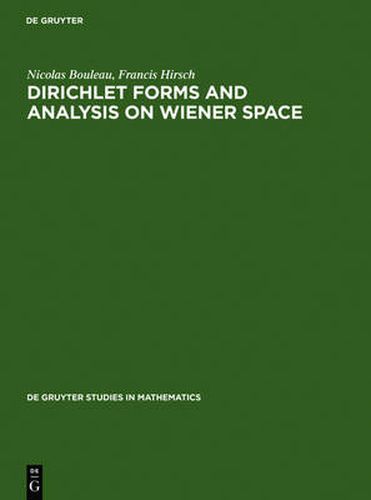Readings Newsletter
Become a Readings Member to make your shopping experience even easier.
Sign in or sign up for free!
You’re not far away from qualifying for FREE standard shipping within Australia
You’ve qualified for FREE standard shipping within Australia
The cart is loading…






This title is printed to order. This book may have been self-published. If so, we cannot guarantee the quality of the content. In the main most books will have gone through the editing process however some may not. We therefore suggest that you be aware of this before ordering this book. If in doubt check either the author or publisher’s details as we are unable to accept any returns unless they are faulty. Please contact us if you have any questions.
The subject of this book is analysis on Wiener space by means of Dirichlet forms and Malliavin calculus. There are already several literature on this topic, but this book has some different viewpoints.
First the authors review the theory of Dirichlet forms, but they observe only functional analytic, potential theoretical and algebraic properties. They do not mention the relation with Markov processes or stochastic calculus as discussed in usual books (e.g. Fukushima’s book). Even on analytic properties, instead of mentioning the Beuring-Deny formula, they discuss carre du champ operators introduced by Meyer and Bakry very carefully. Although they discuss when this carre du champ operator exists in general situation, the conditions they gave are rather hard to verify, and so they verify them in the case of Ornstein-Uhlenbeck operator in Wiener space later. (It should be noticed that one can easily show the existence of carre du champ operator in this case by using Shigekawa’s H-derivative.)
In the part on Malliavin calculus, the authors mainly discuss the absolute continuity of the probability law of Wiener functionals. The Dirichlet form corresponds to the first derivative only, and so it is not easy to consider higher order derivatives in this framework. This is the reason why they discuss only the first step of Malliavin calculus. On the other hand, they succeeded to deal with some delicate problems (the absolute continuity of the probability law of the solution to stochastic differential equations with Lipschitz continuous coefficients, the domain of stochastic integrals (Ito-Ramer-Skorokhod integrals), etc.).
This book focuses on the abstract structure of Dirichlet forms and Malliavin calculus rather than their applications. However, the authors give a lot of exercises and references and they may help the reader to study other topics which are not discussed in this book.
Zentralblatt Math, Reviewer: S.Kusuoka (Hongo)
$9.00 standard shipping within Australia
FREE standard shipping within Australia for orders over $100.00
Express & International shipping calculated at checkout
This title is printed to order. This book may have been self-published. If so, we cannot guarantee the quality of the content. In the main most books will have gone through the editing process however some may not. We therefore suggest that you be aware of this before ordering this book. If in doubt check either the author or publisher’s details as we are unable to accept any returns unless they are faulty. Please contact us if you have any questions.
The subject of this book is analysis on Wiener space by means of Dirichlet forms and Malliavin calculus. There are already several literature on this topic, but this book has some different viewpoints.
First the authors review the theory of Dirichlet forms, but they observe only functional analytic, potential theoretical and algebraic properties. They do not mention the relation with Markov processes or stochastic calculus as discussed in usual books (e.g. Fukushima’s book). Even on analytic properties, instead of mentioning the Beuring-Deny formula, they discuss carre du champ operators introduced by Meyer and Bakry very carefully. Although they discuss when this carre du champ operator exists in general situation, the conditions they gave are rather hard to verify, and so they verify them in the case of Ornstein-Uhlenbeck operator in Wiener space later. (It should be noticed that one can easily show the existence of carre du champ operator in this case by using Shigekawa’s H-derivative.)
In the part on Malliavin calculus, the authors mainly discuss the absolute continuity of the probability law of Wiener functionals. The Dirichlet form corresponds to the first derivative only, and so it is not easy to consider higher order derivatives in this framework. This is the reason why they discuss only the first step of Malliavin calculus. On the other hand, they succeeded to deal with some delicate problems (the absolute continuity of the probability law of the solution to stochastic differential equations with Lipschitz continuous coefficients, the domain of stochastic integrals (Ito-Ramer-Skorokhod integrals), etc.).
This book focuses on the abstract structure of Dirichlet forms and Malliavin calculus rather than their applications. However, the authors give a lot of exercises and references and they may help the reader to study other topics which are not discussed in this book.
Zentralblatt Math, Reviewer: S.Kusuoka (Hongo)